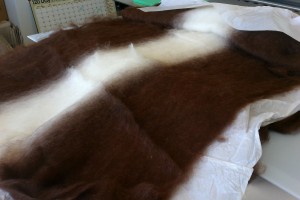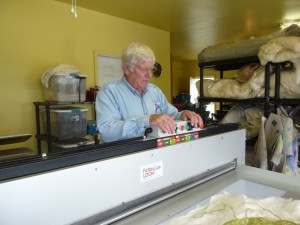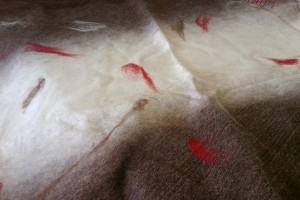So I imagine you have been waiting to hear what happens next after Sandy is done skirting… Once we have separated good from unusable fleece (at least for our purposes), we bag, box and ship the fleece to one of the mills we use for processing. Because we require the processing to be done in particular ways necessary to make the drapy smooth felt in our garments, only a handful of the mills that process alpaca fibers are able to perform our work.

Processing for us means the mill washes, dries and then cards the alpaca fiber to remove coarser fibers and get the fleece fibers all running in the same direction. We have learned that 100% alpaca is not best for our garments and accessories, so the mills blend 25% merino with 75% alpaca during the carding process. What comes off of the carding machine is called a batt. Our batts are extremely thin, usually under 3 ounces; reminds me of a spider web it is so light. For us, the milling process stops there and the batts are returned. Pictured to the left is a gorgeous batt made for us by Evergreen Fleece Processing.
From the batts we design our fabrics. Depending on what we are going to make, the batts of fiber are placed on top of a scrim or stabilizer of different grades of silk, cotton or burlap. We have named each of our fabrics: Silpaca, Silcotton. Also at this point we add whatever accents Sandy’s design calls for.

All the fiber, accents and stabilizer are now run through the FeltLOOM. The intended use of the fabric and the feel and effect we are trying to create will dictate how many times we run the fabric through the loom. Typically this takes 12 or more runs through the machine.

And then, as they say in France, “voila!” Our fabric is ready. And, in case you hadn’t noticed, you can buy this fabric and others in the Whispirit shop. Right now we are offering our hand-dyed and felted Raspberry Silpaca at a special price.
Have a great week…………. Lee
